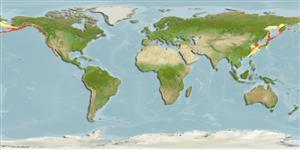Fusitriton oregonensis (Redfield, 1848)
Oregon triton| Native range | All suitable habitat | Point map | Year 2050 |

|
| This map was computer-generated and has not yet been reviewed. |
| Fusitriton oregonensis AquaMaps Data sources: GBIF OBIS |
Adicionar o seu Fotografias
Imagem do Google |
No photo available for this species.No drawings available for Cymatiidae.
Imagem do Google |
No photo available for this species.
Classification / Names Common names | Synonyms | CoL | ITIS | WoRMS
| Littorinimorpha | Cymatiidae
Environment: milieu / climate zone / depth range / distribution range Ecologia
; intervalo de profundidade 0 - 180 m (Ref. 865). Temperate
Distribuição Países | Áreas FAO | Ecossistemas | Ocorrências | Introduções
Pacific Ocean and Northwest Atlantic: Japan, Alaska, Canada, USA. Climate: boreal to subtropical.
Length at first maturity / Tamanho / Peso / Idade
Maturity: Lm ? range ? - ? cm Max length : 15.0 cm SHH macho/indeterminado; (Ref. 865)
The largest intertidal snail (Ref. 95344). It is found on rocky and soft bottoms, in subtidal depths to 180 meters (Ref. 865).
Life cycle and mating behavior Maturidade | Reprodução | Desova | Ovos | Fecundidade | Larvas
Members of the order Neotaenioglossa are mostly gonochoric and broadcast spawners. Life cycle: Embryos develop into planktonic trocophore larvae and later into juvenile veligers before becoming fully grown adults.
Referência principal
Referências | Coordenador | Colaboradores
Backe, N., S. Davies, K. Conley, G. Kosmider, G. Rasmussen, H. Ibey and K. Ladell. 2011. (Ref. 93875)
Categoria na Lista Vermelha da IUCN (Ref. 130435)
Categoria CITES (Ref. 108899)
Not Evaluated
CMS (Ref. 116361)
Not Evaluated
Ameaça para o homem
Utilização humana
| FishSource |
Ferramentas
Mais informação
Idade/Tamanho
Crescimento
Comprimento-peso
Comprimento-comprimento
Morfologia
Larvas
Abundância
Crescimento
Comprimento-peso
Comprimento-comprimento
Morfologia
Larvas
Abundância
Fontes da internet
BHL | BOLD Systems | CISTI | DiscoverLife | FAO(Publication : search) | Fishipedia | GenBank (genoma, nucleotídeo) | GloBI | Gomexsi | Google Books | Google Scholar | Google | PubMed | Árvore da vida | Wikipedia (ir para, procurar) | Registo zoológico
Estimates based on models
Preferred temperature
(Ref. 115969): 2.8 - 15.9, mean 7.8 (based on 714 cells).
Categoria de preço
(Ref. 80766):
Unknown.


